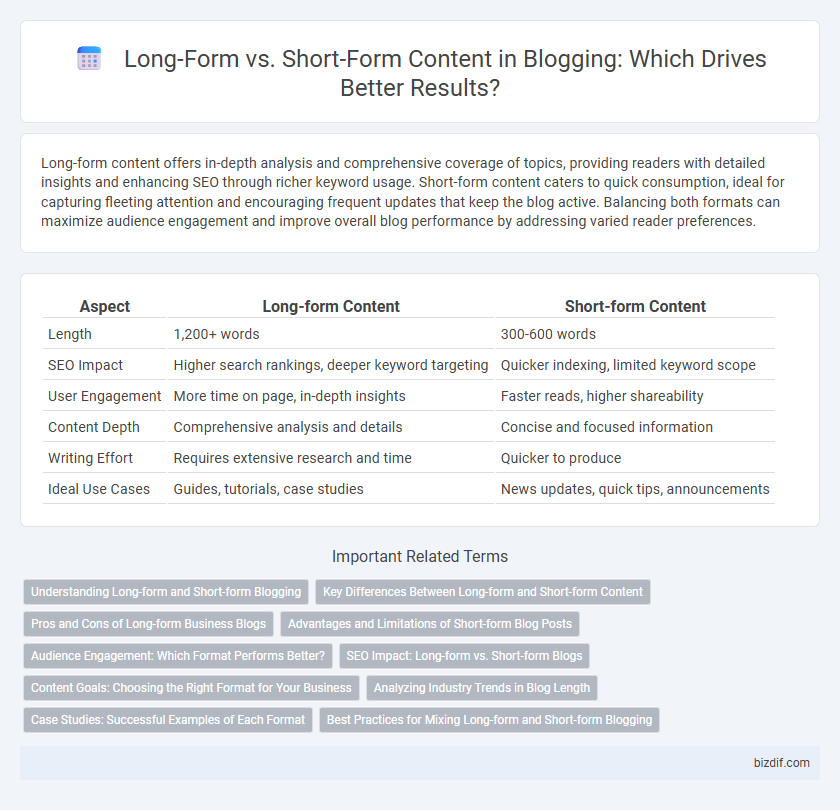Long-form content offers in-depth analysis and comprehensive coverage of topics, providing readers with detailed insights and enhancing SEO through richer keyword usage. Short-form content caters to quick consumption, ideal for capturing fleeting attention and encouraging frequent updates that keep the blog active. Balancing both formats can maximize audience engagement and improve overall blog performance by addressing varied reader preferences.
Table of Comparison
| Aspect | Long-form Content | Short-form Content |
|---|---|---|
| Length | 1,200+ words | 300-600 words |
| SEO Impact | Higher search rankings, deeper keyword targeting | Quicker indexing, limited keyword scope |
| User Engagement | More time on page, in-depth insights | Faster reads, higher shareability |
| Content Depth | Comprehensive analysis and details | Concise and focused information |
| Writing Effort | Requires extensive research and time | Quicker to produce |
| Ideal Use Cases | Guides, tutorials, case studies | News updates, quick tips, announcements |
Understanding Long-form and Short-form Blogging
Long-form blogging typically exceeds 1,200 words and provides in-depth analysis, comprehensive insights, and thorough explanations on a specific topic, making it ideal for establishing authority and improving SEO rankings. Short-form blogging, usually under 600 words, is concise and focuses on quick, digestible content that captures reader attention and encourages frequent posting. Understanding the strengths of both formats allows bloggers to strategically balance detailed content and brief updates to maximize audience engagement and search visibility.
Key Differences Between Long-form and Short-form Content
Long-form content typically exceeds 1,200 words and offers in-depth information, detailed analysis, and comprehensive coverage of a topic, enhancing SEO rankings and user engagement. Short-form content generally ranges from 300 to 600 words, prioritizing quick readability, concise messaging, and immediate value for audiences with limited attention spans. The key differences lie in their purpose, depth of detail, and ideal use cases: long-form excels in thought leadership and complex explanations, whereas short-form suits news updates, social media posts, and brief overviews.
Pros and Cons of Long-form Business Blogs
Long-form business blogs, typically exceeding 1,200 words, offer comprehensive coverage of topics, enhancing search engine optimization (SEO) by targeting multiple keywords and increasing dwell time. These posts establish authority and trust with in-depth analysis and detailed insights, fostering higher engagement and social shares. However, they demand significant time and resources for research and writing, potentially limiting publishing frequency and requiring strong content strategy to maintain reader interest.
Advantages and Limitations of Short-form Blog Posts
Short-form blog posts deliver concise, easily digestible content that caters to readers with limited time, boosting engagement and shareability on social media platforms. Their limitation lies in the reduced depth and detail, which may hinder comprehensive coverage of complex topics and limit SEO potential. Brands use short-form content for quick updates and promotions but must supplement with long-form posts to build authority and provide in-depth insights.
Audience Engagement: Which Format Performs Better?
Long-form blog posts, typically exceeding 1,200 words, foster deeper audience engagement by providing comprehensive insights and encouraging longer read times, which enhance SEO rankings. Short-form content, usually under 600 words, excels in capturing attention quickly and suits mobile readers with limited time, increasing shares and skimming behavior. Analytics show that combining both formats strategically maximizes audience interaction and retention by catering to diverse reader preferences.
SEO Impact: Long-form vs. Short-form Blogs
Long-form blogs, typically exceeding 1,200 words, tend to perform better in SEO by providing comprehensive content that attracts backlinks and increases dwell time. Short-form blogs, usually under 800 words, can drive quick engagement and frequent posting but may struggle to rank for competitive keywords due to limited depth. Balancing both formats strategically enhances keyword coverage and user engagement, optimizing overall search engine visibility.
Content Goals: Choosing the Right Format for Your Business
Long-form content, typically exceeding 1,200 words, excels in establishing authority, boosting SEO rankings, and providing detailed insights ideal for complex topics, while short-form content under 600 words caters to quick consumption and higher engagement on social media platforms. Businesses aiming for in-depth education, organic traffic growth, and comprehensive resource creation benefit from long-form formats, whereas brands focusing on brand awareness, lead generation, and frequent updates often find short-form posts more effective. Selecting the right format depends on target audience preferences, content goals, and distribution channels to maximize impact and return on investment.
Analyzing Industry Trends in Blog Length
Analyzing industry trends in blog length reveals a growing preference for long-form content, with studies showing posts over 2,000 words generate 77% more backlinks and higher engagement rates. Short-form blogs, typically under 800 words, remain popular for quick updates and higher posting frequency, driving consistent traffic in fast-paced niches. Data from SEMrush and HubSpot highlight that combining both formats strategically optimizes SEO performance and audience retention across diverse industries.
Case Studies: Successful Examples of Each Format
Case studies reveal that long-form blogging excels in depth and SEO performance, with examples like Neil Patel's comprehensive marketing guides generating sustained traffic and authoritative backlinks. Short-form blogs, such as HubSpot's concise posts, drive higher engagement rates and social media shares due to quick readability and targeted messaging. Brands strategically use long-form for in-depth education and short-form for timely updates, maximizing audience reach and content effectiveness.
Best Practices for Mixing Long-form and Short-form Blogging
Effective blogging combines long-form and short-form content to balance depth and engagement. Long-form posts exceeding 1,200 words provide comprehensive insights and improve SEO rankings, while short-form articles under 600 words capture quick attention and encourage frequent updates. Strategically mixing both formats leverages keyword diversity and audience retention, maximizing blog performance and reach.
Long-form vs Short-form Infographic

 bizdif.com
bizdif.com